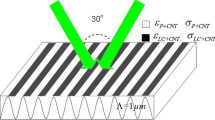Abstract
High performance transmission holographic polymer dispersed liquid crystals were fabricated using a mixture of radically photopolymerizable multifunctional acrylates and ring-opening photopolymerizable epoxides as monomers for matrix components with Nd:YAG laser (λ=532 nm). Functionality of multifunctional acrylates and concentration of LC were varied to optimize the performance of holographic gratings.
Gratings with much higher diffraction efficiency (83% or 67%, respectively) were obtained from recording solution composed of dipentaerythritol penta/hexaacrylate,1vinyl2pyrrolidone, commercial liquid crystal E7, and 1,3-bis(3-glycidoxypropyl)-1,1,3,3-tetramethyldisiloxane with glycidyl function linked with disiloxane, or 1,3-bis[2-(1,2-epoxycyclohex-4-yl)ethyl]-1,1,3,3-tetramethyldisiloxane with cyclohexene oxide function and the same siloxane spacer (45:9:10:36), compared with the ordinary recording solution composed of dipentaerythritol penta/hexaacrylate, 1vinyl2pyrrolidone and E7 (<2%). The recording solution composed of 1,5-bis(3-glycidoxypropyl)-1,1,3,3,5,5-hexamethyltrisiloxane and 1,5-bis[2-(1,2-epoxycyclohex-4-yl)ethyl]-1,1,3,3,5,5-hexamethyltrisiloxane with trisiloxane spacer gave further improved diffraction efficiency (97% and 75%, respectively). Recording solutions contain trisiloxane derivatives gave gratings with considerably or moderately reduced angular deviation (0.83, 0.66 degree for trisiloxane derivatives from 1.2, 0.7 degree for disiloxane derivatives, respectively, for signal beam, and 0.76, 0.70 degree from 1.1, 1.0 degree, respectively, for the reference beam at 32 degree of external incident angle) from Bragg profile, namely 5.2 and 4.5% volume shrinkage for trisiloxane derivatives, and 7.5, 5.6% volume shrinkage for disiloxane derivatives, respectively.
High diffraction efficiency over 95% with angular selectivity of 4.0 degree was obtained for the gratings formed from 1,5-bis[2-(1,2-epoxycyclohex-4-yl)ethyl]-1,1,3,3,5,5-hexamethyltrisiloxane when the concentration of E7 was reduced to 5%. Clearly phase-separated liquid crystal domains were observed by scanning electron microscopy. Grating spacing (about 900 nm) was close to the calculated value (965 nm) by Bragg equation.
Similar content being viewed by others
References
B.J. Luther, G.H. Springer, D.A. Higgins, Chem. Mater. 13, 2281 (2001)
Y.H. Cho, B.K. Kim, J.S. Lee, Polymer 41, 1325 (2000)
T. Kyu, D. Nwabunma, Macromolecules 34, 9168 (2001)
S. Kubo, Z.Z. Gu, K. Takahashi, Y. Ohko, O. Sato, A. Fujishima, J. Am. Chem. Soc. 124, 10950 (2002)
P.S. Drzaic, Liquid Crystal Dispersions (World Scientific, New Jersey, 1995)
M.S. Park, Y.H. Cho, B.K. Kim, J.S. Jang, Curr. Appl. Phys. 2, 249 (2002)
D.J. Pikas, S.M. Kirkpatrick, D.W. Tomlin, L. Natarajan, V. Tondiglia, T.J. Bunning, Appl. Phys. A 74, 767 (2002)
J.A. Jung, B.K. Kim, Opt. Commun. 247, 125 (2005)
T.J. Bunning, L.V. Natarajan, V.P. Tondiglia, R.L. Sutherland, Annu. Rev. Mater. Sci. 30, 83 (2000)
D.E. Lucchetta, L. Criante, F. Simoni, J. Appl. Phys. 93, 9670 (2003)
R.L. Sutherland, L.V. Natarajan, V.P. Tondiglia, T.J. Bunning, Chem. Mater. 5, 1533 (1993)
M. Jazbinsek, I.D. Olenik, M. Zgonik, A.K. Fontecchio, G.P. Crawford, J. Appl. Phys. 90, 3831 (2001)
M.S. Park, B.K. Kim, J.C. Kim, Polymer 44, 1595 (2003)
J. Zhang, C.R. Carlen, S. Palmer, M.B. Sponsler, J. Am. Chem. Soc. 116, 7055 (1994)
D.E. Lucchetta, R. Karapinar, A. Manni, F. Simoni, J. Appl. Phys. 91, 6060 (2002)
Y.H. Cho, C.W. Shin, N. Kim, B.K. Kim, Y. Kawakami, Chem. Mater. 17, 6263 (2005)
Y.H. Cho, M. He, B.K. Kim, Y. Kawakami, Sci. Technol. Adv. Mater. 5, 319 (2004)
Y.H. Cho, R. Kawade, T. Kubota, Y. Kawakami, Sci. Technol. Adv. Mater. 6, 435 (2005)
M. He, Y.H. Cho, N. Kim, Y. Kawakami, Des. Monom. Polym. 8, 473 (2005)
M. He, Y.H. Cho, Y. Kawakami, Polym. J., in press (2006)
J.V. Crivello, D.J. Bi, J. Polym. Sci. Polym. Chem. 31, 2563 (1993)
Z. Gomurashvili, J.V. Crivello, J. Polym. Sci. Polym. Chem. 39, 1187 (2001)
J.V. Crivello, F. Jiang, Chem. Mater. 14, 4858 (2002)
D.A. Waldman, R.T. Ingwall, P.K. Dhal, M.G. Horner, E.S. Kolb, H.-Y.S. Li, R.A. Minns, H.G. Schild, Proc. SPIE 2689, 127 (1995)
U.S. Rhee, H.J. Caulfield, J. Shamir, C.S. Vikram, M.M. Mirsalehi, Opt. Eng. 32, 1839 (1993)
F.H. Mok, Opt. Lett. 18, 915 (1993)
K. Curtis, A. Pu, D. Psaltis, Opt. Lett. 19 (1994)
H. Kogelnik, Bell Syst. Tech. J. 48, 2909 (1969)
G. Montemezzani, M. Zgonik, Phys. Rev. E 55, 1035 (1997)
Author information
Authors and Affiliations
Corresponding author
Additional information
PACS
42.40.Eq
Rights and permissions
About this article
Cite this article
Cho, Y., Kawakami, Y. High performance holographic polymer dispersed liquid crystal systems using multi-functional acrylates and siloxane-containing epoxides as matrix components. Appl. Phys. A 83, 365–375 (2006). https://doi.org/10.1007/s00339-006-3495-2
Received:
Accepted:
Published:
Issue Date:
DOI: https://doi.org/10.1007/s00339-006-3495-2




